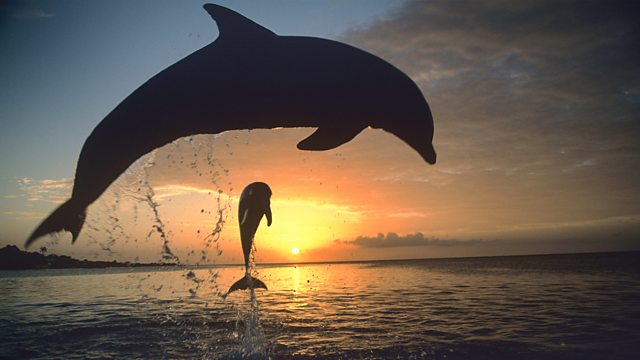Ocean Giants episode 2 – Deep Thinkers: Humans have long wondered if the universe may harbour other intelligent life forms. But perhaps we need look no further than our oceans?
Whales and dolphins, like humans, have large brains, are quick to learn new behaviours and use a wide range of sounds to communicate with others in their society. But how close are their minds to ours? In the Bahamas, Professor Denise Herzing believes she is very close to an answer, theorising that she will be able to hold a conversation with wild dolphins in their own language within five years.
In Western Australia, dolphins rely on their versatile and inventive brains to survive in a marine desert. In Alaska, humpback whales gather into alliances in which individuals pool their specialised talents to increase their hunting success. We discover how young spotted dolphins learn their individual names and the social etiquette of their pod, and how being curious about new objects leads Caribbean bottlenose dolphins to self-awareness and even to self-obsession. Finally, the film shows a remarkable group of Mexican grey whales, who seem able to empathize with humans and may even have a concept of forgiveness.
Ocean Giants episode 2 – Deep Thinkers
Dolphin
Dolphin is the common name of aquatic mammals within the infraorder Cetacea. The term dolphin usually refers to the extant families Delphinidae (the oceanic dolphins), Platanistidae (the Indian river dolphins), named Iniidae (the New World river dolphins), and Pontoporiidae (the brackish dolphins), and the extinct Lipotidae (baiji or Chinese river dolphin). There are 40 extant species named as dolphins.
Dolphins range in size from the relatively small 1.7-metre-long (5 ft 7 in) long and 50-kilogram (110-pound) bodied Maui’s dolphin to the 9.5 m (31 ft 2 in) and 10-tonne (11-short-ton) killer whale. Dolphins can sometimes leap about 30 feet (9.1 m). Several species of dolphins exhibit sexual dimorphism, in that the males are larger than females. They have streamlined bodies and two limbs that are modified into flippers. Though not quite as flexible as seals, some dolphins can travel at speeds 29 kilometres (18 mi) per hour for short distances.
Dolphins use their conical shaped teeth to capture fast-moving prey. They have well-developed hearing which is adapted for both air and water and is so well developed that some can survive even if they are blind. Some species are well adapted for diving to great depths. They have a layer of fat, or blubber, under the skin to keep warm in the cold water.
Gray whale
The gray whale (Eschrichtius robustus), also known as the grey whale, gray back whale, Pacific gray whale, or California gray whale, is a baleen whale that migrates between feeding and breeding grounds yearly. It reaches a length of 14.9 meters (49 ft), a weight of up to 41 tonnes (90,000 lb) and lives between 55 and 70 years, although one female was estimated to be 75–80 years of age. The common name of the whale comes from the gray patches and white mottling on its dark skin.
Gray whales were once called devil fish because of their fighting behavior when hunted. The gray whale is the sole living species in the genus Eschrichtius, which in turn is the sole living genus in the family Eschrichtiidae. This mammal is descended from filter-feeding whales that appeared at the beginning of the Oligocene, over 30 million years ago.
